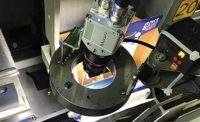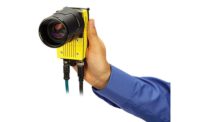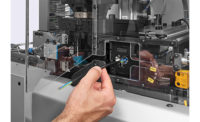For most machine vision applications, gray-scale images are just fine. In some cases, however, vision systems that detect color can be an important tool for verifying that the correct components are present in an assembly.
Some production tasks, such as checking the color of wiring, can only be done with a color vision system. Other tasks, such as searching for objects, can also benefit from the additional information color brings.
As costs come down and the technology improves, engineers have more opportunity than ever to implement color vision systems on assembly lines. Today compact systems designed specifically for inspection applications feature smart tools that greatly simplify programming.
“The biggest advantage of investing in a color vision system is that you have the capability there when you need it,” says Steven King, machine vision and lighting product manager at Microscan Systems Inc. “Most inspections work well in monochrome. But, there are cases when only color will give you the ability to discriminate the part from the background and inspect it.”
“The main advantage of color processing is that it can detect and bring out very subtle color differences on a target that monochrome cannot,” adds Douglas Kurzynski, project manager for machine vision technology at Keyence Corp. of America. “Monochrome cameras simply have 256 levels of intensity for each pixel, so all colors are inside this small range based off their intensity.
“On the other hand, color cameras have 256 levels of red, green and blue, which basically offers more than 16 million combinations of color,” Kurzynski points out. “With color processing, you can select the exact color that you would like to analyze with the vision system.”
But, the majority of machine vision applications can be solved using monochrome camera systems. Even many color sorting applications can be accomplished with monochrome camera systems and proper filtering.
“Color is often not necessary,” explains King. “Most colors will show up as different gray scales and are easy to inspect in a monochrome image. Often, it simply takes using a special color light to get the color you are interested in to stand out from the background.”
“However, there are some applications where a color camera can be useful,” says Nick Sischka, optical engineer at Edmund Optics Inc. “Namely, any system that contains several different colors to be recognized, or incredibly low resolution systems that only require color confirmation. Systems that are used for color differentiation can require high sensitivity, and color cameras are incredibly useful for this.”
Unfortunately, manufacturing engineers don’t always see the advantage of using color.
“One of the main misconceptions is that color vision systems can tell fine differences between different shades within the same color family, similar to a colorimeter,” says King. “Color cameras often don’t offer the color depth in terms of bits per pixel to tell fine differences between colors—only gross color differentiation.”
“Another misconception is that there is no tradeoff to be made when going with a color camera over a monochrome camera with the same sensor,” notes Sischka. “However, color cameras have several drawbacks over monochrome cameras, such as lower sensitivity and resolution when compared to their monochrome counterparts. There is often little to no advantage to using a color system over a monochrome one.”
“Color images allow you to see different contrasts and capture more data,” says Jim Anderson, national product manager for machine vision at SICK Inc. “Although color offers more flexibility, sometimes there’s also more complexity. You have to either do something with all the additional data or ignore it. If you choose the latter, that defeats the purpose of having a color camera.”
“Some engineers mistakenly believe that color processing is harder to use than gray scale,” adds Kurzynski. “Actually, most vision tools work off a gray-scale image anyway, so really, the only difference is just picking the color that you want to highlight.
“Once that is done, the tool setup is the same regardless of a color camera or gray-scale camera,” claims Kurzynski. “There are several color-to-gray-scale conversion methods that can be used to bring out the defects and features that are needed.”
Cost Concerns
Cost is another common misnomer. While there is a perceived difference, there’s not a huge leap in price when you go from gray-scale to color systems.
Many camera manufacturers offer monochrome and color versions of their products at approximately the same price, especially in the two- to five-megapixel range. Sometimes, there’s only a few hundred dollars difference. But, other color processing vision tools are often sold at a premium.
“Color and gray-scale vision technology is actually about the same price,” says Benjamin Dawson, Ph.D., director of strategic development at Teledyne DALSA Industrial Products Inc. “However, there can be additional costs for proper lighting and controlling camera temperature, if necessary. And, if the process is rapid, you might need a more capable processor to keep up.”
“It’s certainly more than just the cost of the camera, which has approached price parity with its monochrome counterpart at the entry level,” adds Arnaud Lina, vision tools development manager at Matrox Imaging. “For color imaging, you need a controlled environment, uniform illumination, an enclosure, some calibration process and filters, which all add to the cost.”
“While the cost of color variants of the same camera model is usually nearly the same, there are often hidden costs to choosing a color camera,” warns Sischka. “Since using a color camera typically precludes the use of monochrome lights, choosing a lens that is color-corrected for use with white light can often lead to the selection of a more expensive lens.
“These lenses will perform better still when used on a monochrome camera and with a monochrome light, however,” claims Sischka. “So, it is often not worth it to go with the color camera.
“If a high-resolution color image is required, 3CCD cameras (devices that use three separate charge-coupled devices) are available,” Sischka points out. “These cameras utilize a special prism assembly inside the camera body to split the incoming light into red, green and blue. These split light paths are then directed toward three separate sensors, optimized for the absorption of that particular color of light.
“When the color image is reconstructed, there is no loss in resolution,” explains Sischka. “However, these cameras require special 3CCD lenses that do not protrude into the camera body and interfere with the prism assembly.”
A manufacturer in Illinois recently addressed cost concerns head-on before it invested in a color vision system for an assembly line that mass-produces rear bumpers for the auto industry. It eventually purchased four Cognex vision systems to accurately distinguish between different color-matched reverse-parking assist (RPA) sensors and bezels. The safety devices emit high-frequency sound waves and are integrated into the bumpers.
The manufacturer estimated the cost of manual inspection over three shifts to be $200,000 per year. Its new automated inspection system, which ensures that the colors of each bumper and RPA sensor assembly match, cost only a fraction of that.
“We briefly considered the option of adding an additional inspector to check the color of the sensor and bezel,” says Kerry Pokorny, a controls engineer who worked on the project. “We felt this cost was too high to justify, so we decided to look at whether we could automate the color-match inspection using color machine vision technology.
“The new vision system cost under $40,000, including all accessories,” adds Pokorny. “[It] has no ongoing expense, so the payback on the investment was just a few months.”
Moving on Up
Graduating from gray-scale to color vision systems has never been easier, but it can be a daunting task for some engineers.
“Gray-scale algorithms are quite different than color algorithms, so there is some learning to be done,” says Dawson. “Many standard, gray-scale machine vision algorithms, such as edge detection, don’t exist or are less useful in a color vision system.
“In general, you want a monochrome system for measuring things such as edge-to-edge distances (calipers) or pattern-matching based on part outlines,” explains Dawson. “Color systems generally work on area measures, such as size of color areas in an object and the areas’ positions.”
Typically, the complexity involved in making the shift from monochrome to color depends entirely on the inspection task.
“Some applications, such as multiple color differentiation, are made simpler by making the switch to a color system, [while other] applications, particularly high-resolution inspections, are made simpler by using a monochrome system,” says Sischka. “Color cameras give the user access to a different, specialized toolbox for color sorting that can be difficult to achieve with a monochrome system.”
According to Microscan’s King, the vision system should be able to grab images from color cameras. It also must have the tools needed to work with color images.
“Not all of them do,” warns King. “The added complexity of a color system is often just learning the color tools offered by the manufacturer.
“Also, red is the de facto standard LED color for monochrome images,” adds King. “White lights need to be used instead for color imaging. These lights need to be wide spectrum lights. Many white lights have a heavy blue component to them. Often, you need to color balance the camera to get the best discrimination between colors.”
Inexperience is another factor that causes some engineers to shy away from using color vision systems.
“Newer users might think color processing is difficult to perform vs. monochrome,” says Keyence’s Kurzynski. “There is slightly more processing needed, so processing time is slightly higher than monochrome. That could be a deterrent for some [people]. But, with the latest hardware, color processing is done at very high speeds.
“Also, since color cameras use what is called a Bayer filter, where each pixel relies on its neighbors to get its full color information, they are technically not as accurate as monochrome cameras [for applications such as] measuring edges,” explains Kurzynski. “So, when it comes to gauging measurements with vision, monochrome cameras will still offer a more accurate measurement than color would.”











